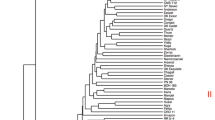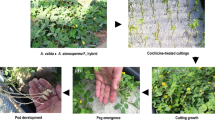Abstract
A fertile amphidiploid × Brassicoraphanus (RRCC, 2n = 36) between Raphanus sativus cv. HQ-04 (2n = 18, RR) and Brassica alboglabra Bailey (2n = 18, CC) was synthesized and successive selections for seed fertility were made from F4 to F10. F10 plants exhibited good fertility with 14.9 seeds per siliqua and 32.3 g seeds per plant. Cytological observation revealed that frequent secondary pairing occurred among 3 chromosome pairs in pollen mother cells of plants (F4) with lower fertility, but not of plants with high fertility (F10). GISH analysis indicated that these F10 plants included the expected 18 chromosomes from R. sativus and B. alboglabra, respectively, but they lost approximately 27.6% R. sativus and 35.6% B. alboglabra AFLP (amplified fragment length polymorphism) bands. The crossability of the Raphanobrassica with R. sativus and 5 Brassica species (13 cultivars) were investigated. Seeds or F1 seedlings were easy to be produced from crosses × Brassicoraphanus × R. sativus, and B. napus, B. juncea and B. carinata × Brassicoraphanus. Fewer seeds or seedlings were obtained from crosses × Brassicoraphanus × B. napus, B. juncea and B. carinata. However, few seeds were harvested in the reciprocals of × Brassicoraphanus with B. rapa and B. oleracea. The possible cause of fertility improvements and the potential of the present × Brassicoraphanus for breeding were discussed.


Similar content being viewed by others
References
Becker HC, Engqvist GM, Karlsson B (1995) Comparison of rapeseed cultivars and resynthesized lines based on allozyme and RFLP markers. Theor Appl Genet 91:62–67
Cheung WY, Champagne N, Hubert N, Landry BS (1997) Comparison of genetic maps of Brassica napus and Brassica oleracea. Theor Appl Genet 94:569–584
Chopinet R (1944) Hybrids intergénériques Raphano-Brassica. Rev Hortic 116:98–100
Dolstra O (1982) Synthesis and fertility of Brassicoraphanus and ways of transferring Raphanus characters to Brassica. Agric Res Rep 917:1–90
Ellerström S, Zagorcheva L (1977) Sterility and apomictic embryo-sac formation in Raphanobrassica. Hereditas 87:107–120
Feldman L, Levy AA (2005) Allopolyploidy – a shaping force in the evolution of wheat genomes. Cytogenet Genome Res 109:250–258
Gladis T, Hammer K (2001) Nomenclatural notes on the Brassica oleracea-group. Genetic Resour Crop Evol 48:7–11
Gómez-Campo C (1999) Biology of Brassica coenospecies. Elsevier, Amsterdam, the Netherlands, pp 1–32
Hagimori M, Nagaoka M, Kato N, Yoshikawa H (1992) Production and characterization of somatic hybrids between the Japanese radish and cauliflower. Theor Appl Genet 84:819–824
Harberd DJ, McArthur ED (1980) Meiotic analysis of some species and genus hybrids in the Brassicaceas. In: Tsunoda S, Hinata K, Gómez-Campo C (eds) Brassica crops and wild allies. Japan Science Society Press, Tokyo, pp 65–87
Howard HW (1938) The fertility of amphidiploids from the cross Raphanus sativus × Brassica oleracea. J Genet 56:239–273
Jenczewski E, Eber F, Grimaud A, Huet S, Lucas MO, Monod H, Chevre AM (2003) PrBn, a major gene controlling homeologous pairing in oilseed rape (Brassica napus ) haploids. Genetics 164:645–653
Lange W, Toxopeus H, Lubberts JH, Dolstra O, Harrewijn JL (1989) The development of Raparadish (×Brassicoraphanus, 2n = 38), a new crop in agriculture. Euphytica 40:1–14
Lelivelt CLC, Lang W, Dolstra O (1993) Intergeneric crosses for the transfer of resistance to the beet cyst nematode from Raphanus sativus to Brassica napus. Euphytica 68:111–120
Li Z, Liu HL, Luo P (1995) Production and cytogenetics of intergeneric hybrids between Brassica napus and Orychophragmus violaceus. Theor Appl Genet 91:131–136
Lukens LN, Pires JC, Leon E, Vogelzang R, Oslach L, Osborn T (2006) Patterns of sequence loss and cytosine methylation within a population of newly resynthesized Brassica napus allopolyploids. Plant Physiol 140:336–348
Matsuzawa Y, Funayama T, Kamibayashi M, Konnai M, Bang SW, Kaneko Y (2000) Synthetic Brassica rapa-Raphanus sativus amphidiploid lines developed by reciprocal hybridization. Plant Breed 119:357–359
McNaughton IH (1973) Resistance of Raphanobrassica to clubroot disease. Nature 243:547–548
Mizushima V (1980) Genome analysis in Brassica and allied genera. In: Tsunoda S, Hinata K, Gómez-Campo C (eds) Brassica crops and wild allies. Japan Scientific Societies Press, Tokyo, pp 89–105
Namai H (1976) Cytogenetic and breeding studies on transfer of economic characters by menas of interspecific and intergeneric crossing in the tribe Brassiceae of Cruciferae. Mem Fac Agric Tokyo Univ Edu 22:101–107
Namai H, Sarashima M, Hosoda T (1980) Interspecific and intergeneric hybridization breeding in Japan. In: Tsunoda S, Hinata K, Gomez-Campo C (eds) Brassica crops and wild allies. Japan Science Society Press, Tokyo, pp 191–202
Olesson G, Ellerström S (1980) Polyploidy breeding in Europe. In: Tsunoda S, Hinata K, Gomez-Campo C (eds) Brassica crops and wild allies. Japan Science Societies Press, Tokyo, pp 167–190
Paulmann W, Röbbelen G (1988) Effective Transfer of Cytoplasmic Male Sterility from Radish (Raphanus sativus L.) to Rape (Brassica napus L.). Plant Breeding 100:299–309
Peterka H, Budahn H, Schrader O, Ahne R, Schütze W (2004) Transfer of resistance against the beet cyst nematode from radish (Raphanus sativus) to rape (Brassica napus) by monosomic chromosome addition . Theor Appl Genet 109:30–41
Prakash S, Takahata Y, Kirti PB, Chopra VL (1999) Cytogenetics. In: Gómez-Campo C (ed) Biology of Brassica coenospecies. Elsevier, Amsterdam, The Netherlands, pp 59–106
Qian W, Chen X, Fu D, Zou J, Meng J (2005) Intersubgenomic heterosis in seed yield potential observed in a new type of Brassica napus introgressed with partial Brassica rapa genome. Theor Appl Genet 110:1187–1194
Richharia RH (1937) Cytological investigation of Raphanus sativus, Brassica oleracea, and their F1 and F2 hybrids. J Genet 34:19–44
Riley R, Chapman V (1958) Genetic control of the cytologically diploid behaviour of hexaploid wheat. Nature 13:713–715
Sageret M (1826) Considerations sur la production des variants et des variétés en general, et sur celles de la famille de cucurbitaceés en particulier. Ann Sci Nat 8:294–314
Snowdon RJ, Köhler W, Friedt W, Köhler A (1997) Genome in situ hybridization in Brassica amphidiploids and interspecific hybrids. Theor Appl Genet 95:1320–1324
Soltis DE, Soltis PS, Tate JA (2003) Advances in the study of polyploidy since plant speciation. New Phytologist 161:173–191
Takeshita M, Kato M, Tokumasu S (1980) Application of ovule culture to the production of intergeneric hybrids in Brassica and Raphanus. Jpn J Genet 55:573–587
Tokumasu S, Kato M (1988) Chromosomal and genic structure of Brassicoraphanus related to seed fertility and the presentation of an instance of improvement of its fertility. Euphytica 39:145–151
Vos P, Hogers R, Bleeker M, Reijans M, van de Lee T, Hornes M, Frijters A, Pot J, Peleman J, Kuiper M (1995) AFLP: a new technique for DNA fingerprinting. Nucleic Acids Res 23:4407–4414
Voss A, Snowdon RJ, Lühs W, Friedt W (2000) Intergeneric transfer of nematode resistance from Raphanus sativus into the Brassica napus genome. Acta Hort 539:129–134
Warwick SI, Black LD (1991) Molecular systematics of Brassica and allied genera (subtrib Brassicinae, Brassiceae) – choroplast genome and cytodeme congruence. Theor Appl Genet 82:81–92
Acknowledgements
This work was supported by Huibei provincial project (2004AA204A-2), Chinese Ministry of Science and Technology (863 project, 2001AA241101), Changjiang Scholars and Innovative Research Team in University (IRT0442) PR China.
Author information
Authors and Affiliations
Corresponding author
Rights and permissions
About this article
Cite this article
Chen, H.G., Wu, J.S. Characterization of fertile amphidiploid between Raphanus sativus and Brassica alboglabra and the crossability with Brassica species. Genet Resour Crop Evol 55, 143–150 (2008). https://doi.org/10.1007/s10722-007-9223-8
Received:
Accepted:
Published:
Issue Date:
DOI: https://doi.org/10.1007/s10722-007-9223-8




